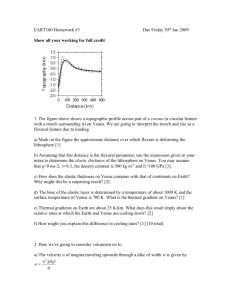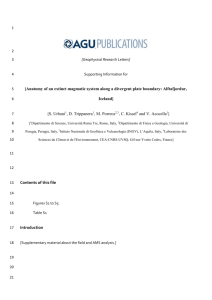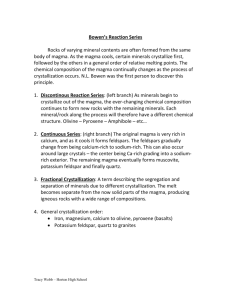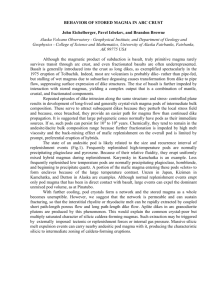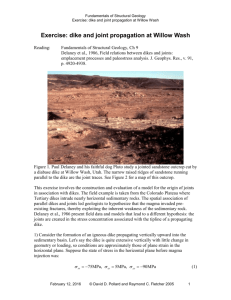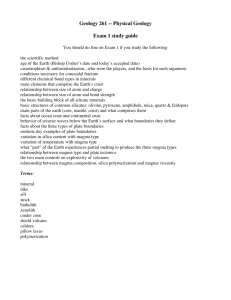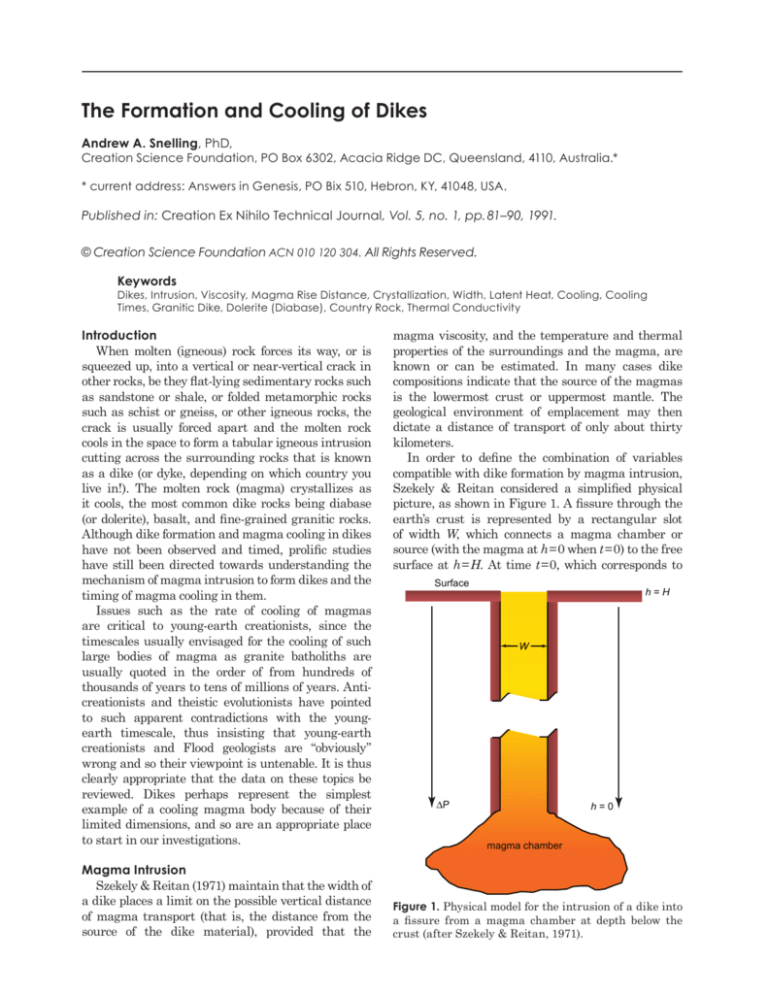
The Formation and Cooling of Dikes
Andrew A. Snelling, PhD,
Creation Science Foundation, PO Box 6302, Acacia Ridge DC, Queensland, 4110, Australia.*
* current address: Answers in Genesis, PO Bix 510, Hebron, KY, 41048, USA.
Published in: Creation Ex Nihilo Technical Journal, Vol. 5, no. 1, pp. 81–90, 1991.
© Creation Science Foundation ACN 010 120 304. All Rights Reserved.
Keywords
Dikes, Intrusion, Viscosity, Magma Rise Distance, Crystallization, Width, Latent Heat, Cooling, Cooling
Times, Granitic Dike, Dolerite (Diabase), Country Rock, Thermal Conductivity
Introduction
When molten (igneous) rock forces its way, or is
squeezed up, into a vertical or near-vertical crack in
other rocks, be they flat-lying sedimentary rocks such
as sandstone or shale, or folded metamorphic rocks
such as schist or gneiss, or other igneous rocks, the
crack is usually forced apart and the molten rock
cools in the space to form a tabular igneous intrusion
cutting across the surrounding rocks that is known
as a dike (or dyke, depending on which country you
live in!). The molten rock (magma) crystallizes as
it cools, the most common dike rocks being diabase
(or dolerite), basalt, and fine-grained granitic rocks.
Although dike formation and magma cooling in dikes
have not been observed and timed, prolific studies
have still been directed towards understanding the
mechanism of magma intrusion to form dikes and the
timing of magma cooling in them.
Issues such as the rate of cooling of magmas
are critical to young-earth creationists, since the
timescales usually envisaged for the cooling of such
large bodies of magma as granite batholiths are
usually quoted in the order of from hundreds of
thousands of years to tens of millions of years. Anticreationists and theistic evolutionists have pointed
to such apparent contradictions with the youngearth timescale, thus insisting that young-earth
creationists and Flood geologists are “obviously”
wrong and so their viewpoint is untenable. It is thus
clearly appropriate that the data on these topics be
reviewed. Dikes perhaps represent the simplest
example of a cooling magma body because of their
limited dimensions, and so are an appropriate place
to start in our investigations.
Magma Intrusion
Szekely & Reitan (1971) maintain that the width of
a dike places a limit on the possible vertical distance
of magma transport (that is, the distance from the
source of the dike material), provided that the
magma viscosity, and the temperature and thermal
properties of the surroundings and the magma, are
known or can be estimated. In many cases dike
compositions indicate that the source of the magmas
is the lowermost crust or uppermost mantle. The
geological environment of emplacement may then
dictate a distance of transport of only about thirty
kilometers.
In order to define the combination of variables
compatible with dike formation by magma intrusion,
Szekely & Reitan considered a simplified physical
picture, as shown in Figure 1. A fissure through the
earth’s crust is represented by a rectangular slot
of width W, which connects a magma chamber or
source (with the magma at h = 0 when t = 0) to the free
surface at h = H. At time t = 0, which corresponds to
Surface
h=H
W
�P
h=0
magma chamber
Figure 1. Physical model for the intrusion of a dike into
a fissure from a magma chamber at depth below the
crust (after Szekely & Reitan, 1971).
2
the opening of the fissure, the static pressure acting
on the magma ∆P will force the magma upward
through the fissure.
As the magma rises it encounters wall rock of
progressively lower temperature. The resultant heat
loss causes a substantial increase in viscosity and at
least partial crystallization. The increase in viscosity,
the partial blockage of the slot, and the reduction in
the effective driving force will hinder upward flow.
Should crystallization be completed before the free
surface (or any other elevation of h above the magma
chamber that is of interest) is reached, the mechanism
is ruled out for the given geometry.
A rigorous formulation of the problem, where
allowance is made for the two-dimensional nature
of the velocity and temperature fields, and
simultaneously, account is taken of the interaction
of the velocity field with rate of crystallization
and inward-moving (from the walls of the fissure)
solidification front, results in a rather complex set
of partial differential equations. Thus Szekely &
Reitan considered it preferable, at least as a first
approximation, to examine the asymptotic behavior
of the system. They first considered the rise of
magma in a rectangular slot without crystallization
and developed expressions relating the rate of
rise of the magma toward the free surface to other
parameters, such as width of the slot, viscosity, etc.
Then they determined the time required for complete
crystallization as a function of dike width, for given
values of the latent heat of fusion and the difference
of temperature between the wall rock and the solidus
temperature of the magma (that is, that temperature
at which the originally liquid magma has completely
solidified).
Using the parameters already depicted in Figure
1, at t = 0 magma enters the slot from the magma
chamber and is forced upward owing to the pressure
of the overburden acting on the walls of the magma
chamber. To describe the rise of the magma within
the slot, Szekely & Reitan made the following
assumptions:–
1. the flow is laminar throughout;
2. entrance and inertial effects can be neglected;
3. there are no radial gradients within the slot;
4. for the effect of gradual cooling of the magma
throughout its rise, the viscosity can be considered
as a given function of the vertical position h,
varying over a specified permitted range;
and
5. frictional heat generated by viscous flow can be
neglected.
Although restrictive, the assumptions represent
a reasonable compromise between faithful
representation of reality and the desired mathematical
simplicity. Assumptions 1, 2, and 5 can be justified in
A. A. Snelling
hindsight from their computed results, which show
that the rise time is only significantly affected by
the passage of the magma in the upper portion of the
slot, where the assumptions would appear to be valid.
Assumption 3 is very reasonable for most cases, in
view of the fact that the ratio between H (the height
the magma rises from the magma chamber to the free
surface) and W (the width of the dike) is very much
greater than 1.
Within the framework of these assumptions and
their physical model, Szekely & Reitan concluded
that the position of the top of the magma within the
slot is readily described by a first-order differential
equation which relates the rate of rise of the magma
to the width of the dike, the static pressure due to the
overburden load, the magma density, the acceleration
due to gravity, the distance risen by the magma,
and the position-dependent viscosity. The variation
of viscosity as a function of position in the crust is
dependent on the following facts:–
1. the viscosity is an exponential function of
temperature;
2. the ambient temperature increases with depth;
and
3. viscosity is dependent on pressure, which increases
with depth.
After integration of their first-order differential
equation, Szekely & Reitan derived a simplified
equation which they then used to perform
computations, substituting in appropriate property
values:–
• the static pressure, ∆P = 8 × 109 dynes cm-2
• the magma density, ρ = 2.7 g cm-2
• the viscosity at h = 0, µo = 105g cm-1 sec-1
• the viscosity at h = H, µH = 1010g cm-1 sec-1
Their computations were then used to construct
curves relating the time of rise of the magma to the
width of a dike for six different heights above the
top of the magma chamber (Figure 2). Also shown
in this figure are curves relating time required for
complete crystallization to the width of a dike, for
two different values of the latent heat liberated by
crystallization.
In their computation of the time of crystallization,
Szekely & Reitan assumed that heat transfer
is by conduction only and solely in the direction
perpendicular to the dike in a semi-infinite medium.
Parameters used were:–
• the thermal diffusivity of the magma
4 × 10-3 cm2 sec-1
• the thermal diffusivity of the surrounding rock
6 × 10-3 cm2 sec-1
• the initial temperature of the magma, taken to
represent the liquidus temperature (the lowest
temperature at which the magma is still totally
liquid) 1200 °C
3
The Formation and Cooling of Dikes
gm
ar
ise
ta n
dis
ce
103
1
10
L=
h=
Time in Years
m
m
m
4km
29k = 28k
26k h = 2
h
h=
10
L=
150
cal
0c
g -1
al g -
h=
102
m
20k
h=
1
m
16k
10-1
10-2
0.1
1
10
Dike width (W) in meters
100
Figure 2. Graph showing the time of rise of magma
versus dike width W, with height of rise of the magma
through the earth’s crust as the parameter h, and also
time of complete crystallization versus dike width, with
the latent heat of crystallization as the parameter L
(after Szekely & Reitan, 1971).
• the temperature at which crystallization is assumed
to be completed 1000 °C
• the latent heat of fusion liberated uniformly over
the temperature range 1200 °C to 1000 °C 150 or
100 cal g-1
• the initial temperature of the surrounding rock
600 °C
These assumptions made by Szekely & Reitan avoid
underestimating the time required for complete
crystallization.
Assessing the results as plotted on Figure 2, it
should be noted that the region to the lower left of
the lines labeled with values of h is ruled out, as the
magma would not have reached the height in the time
available. Similarly, the region to the upper left of the
lines labeled with values of L (the latent heat) is ruled
out, since complete crystallization of the dike will have
occurred. Critical limiting values of dike width for any
combination of latent heat fusion and height above the
magma chamber are given by the intersections of the
lines. The locus of such intersections, relating height
of rise of magma to dike width for values of L, is
shown in Figure 3. The curves define an “impossible”
region to the upper left and a “feasible” region to the
lower right.
Of particular interest are the timescales involved
in the rise of the magma from the considerable
depths of the lowermost crust and for crystallization
to occur. Since the region to the left of the lines
labeled with values of latent heat L is ruled out, this
imposes a maximum time for the rise of a magma
into a fissure and subsequent crystallization. Taking
the critical limiting values of dike width for any
combination of latent heat fusion again (but this
time the intersections of the lines give the timespans
involved) the locus of such intersections, relating time
of rise and crystallization to dike width for values of
L, is shown in Figure 4. Again, the curves define an
“impossible” region to the upper left and a “feasible”
region to the lower right.
Comparing Figures 2 and 4, it is thus possible to
calculate that for a dike of width 12 meters, the time
taken for the magma to rise from a depth of around 29
kilometers and then crystallize is definitely less than
five or six years, and probably less than three years.
Significantly, most dikes are narrower than twelve
meters, so this represents a limiting timespan for dike
formation. Furthermore, Szekely & Reitan concluded
that their approach, and their selection of values for
L = 150 cal g-1
30
“IMPOSSIBLE” Region
Magma rise distance (h) in kilometers
Ma
104
L = 100 cal g-1
25
20
15
0
2
4
6
8
10
Dike width (W) in meters
12
Figure 3. Graph showing the locus of intersections of
height of rise of the magma h versus width of the dike
W in Figure 2, defining an “impossible” region above
and/or to the left of the curves and a “permitted” region
below and/or to the right of the curves (after Szekely &
Reitan, 1971).
4
10
9
8
7
6
5
4
3
L = 150 cal g-1
�
“IMPOSSIBLE” Region
�
�
2
Time in years
their computations, tended to underestimate.
At dike widths greater than 12 meters, Szekely
and Reitan’s analysis appears to be inadequate.
On Figure 2 it can be seen that it is impossible to
relate the height of the magma rise parameter
to the time and width parameters, but even a
dike as wide as 100 meters, ignoring the height
of rise parameter, can be seen, according to the
graph, as taking less than 300 or 400 years to
form and crystallize.
A. A. Snelling
�
1
0.9
0.8
0.7
0.6
0.5
0.4
0.3
L = 100 cal g-1
Cooling Times
In an earlier study, Jaeger (1957) modeled
the cooling by conduction of an intrusive sheet
of magma—a dike (or sill, in the case of a
0.2
horizontal sheet)—taking into account the effect
of heat of solidification. As in any analysis of this
0.1
type, a number of general assumptions must be
0.09
0.08
made. Jaeger assumed that:–
1. the intrusive body is in the form of a flat sheet
extending indefinitely in the perpendicular
0
2
4
6
8
10
12
direction—a reasonable approximation to
Dike width (W) in meters
most dikes.
Figure 4. Graph showing the locus of intersections between
2. the intrusion takes place rapidly, that is, in a time in years for rise and cooling of the magma versus width
time which is very short compared to the time of the dike W as derived from Figure 2, again defining an
of solidification.
“impossible” region above and/or to the left of the curves and a
3. the country rock is at constant temperature “permitted” region below and/or to the right of the curves.
which will be taken to be zero. (If it is not
zero, Jaeger concluded that the results of his
and 7. In each case the temperatures are plotted as
analysis should be added to the initial country rock
functions of the time in years for selected points of
temperature.)
the dike, measured from the centre of the dike as
4. the magma is supposed to be intruded at a constant
distances 0, 0. 1D, 0.2D, 0.3D, and 0.4D (in the dike),
temperature, which, for simplicity, will be taken
0.5D (which is the edge of the dike and the contact
to be the liquidus temperature appropriate to its
with the country rocks), and then 0.6D, 0.7D, 0.8D,
composition. (There is good geological evidence
0.9D, and 1.0D (in the country rock), where D is the
that this is frequently the case.)
thickness of the dike in meters. The timescale is
5. the thermal properties of the country rock and
expressed as a factor of D2.
solidified magma are the same and are independent
Figure 5 represents the family of cooling curves
of temperature. (This assumption was again made
for a typical granitic dike, where the temperature of
for simplicity, but it is a reasonable one in view of
the magma at the time of intrusion T2 = 700 °C, the
the uncertainty of these quantities.)
temperature of solidification T1 = 500 °C, the latent
6. heat removed by escaping volatiles need not be
heat of solidification (or fusion) L = 80 cal g-1, and the
considered. (Since the effects of volatiles are
density of the magma ρ = 2.7 g cm-3. The cooling time
dispersed over a region whose thickness is many
for complete crystallization (or solidification) is the
times that of the magma sheet, it is reasonable
time taken for the temperature of the magma at the
to assume that the heat conveyed by them is also
center of the dike to fall from its initial temperature
dispersed over a large region and so will make
T2 to the temperature of solidification T1. In this case
little contribution to the temperature in the narrow
it is the time taken for the magma at the center of the
region which is heated by conduction from the
dike to fall from 700 °C to 500 °C, and can be read
cooling sheet.)
directly from the graph as 0.016D2 years, where D is
7. the effects of convection in the magma can be
the thickness of the dike. Thus a granitic dike one
neglected and cooling is by conduction only.
meter wide would take 0.016 years to crystallize, a
After developing a numerical solution from first
two meter wide granitic dike would take 0.064 years,
principles, Jaeger presented his results as families
a five meter wide granitic dike would take 0.4 years,
of curves of temperature against time. Solutions for
and a ten meter wide granitic dike would take 1.6
three typical cases are presented in Figures 5, 6,
years to crystallize, etc.
�
�
The Formation and Cooling of Dikes
5
Temperature (°C)
Temperature (°C)
0
However, this does
0.1
not take into account
D
0.2
600
complete cooling to
D
0.3D
ambient temperatures
from the temperature
0.4D
of
crystallization
0.5D
400
of 500 °C. Once the
0.6D
center DIKE
granitic dike reached
contact
0.7D
0.8D
COUNTRY ROCK
that
crystallization
0.9D
1.0D
temperature at its
200
center, it would then
take still further time
for the dike and the
surrounding country
0.03D2
0
0.01D2
0.02D2
rock to cool right down
Time (years)
again to ambient Figure 5. Graph showing the family of curves for the cooling history of a dike of thickness
temperatures. This of D meters for which the intrusion temperature is 700 °C, the solidification temperature
course is depicted in the 500 °C, and the latent heat of solidification is 80 cal g-1. The labels on the curves are
diagram by the partial distances from the center of the dike measured as fractions of the thickness D (after
extension of the family Jaeger, 1957).
of curves beyond the time of crystallization. If the
temperature of solidification T1 = 800 °C, the latent
curves are projected (extrapolated) even further until
heat of solidification L = 100 cal g-1, the density of the
the dike is completely cooled, the time taken would
magma ρ = 2.8 g cm-3 —are the same in both examples.
2
appear to be about 0.09D years. In the case then of a
The times for complete solidification (crystallization)
ten meter wide granitic dike, complete cooling would
are 0.012D2 and 0.014D2 years respectively. Thus, a
appear to take about nine years.
dolerite dike intruded at a temperature of 1000 °C
Figures 6 and 7 correspond to a typical diabase
which is one meter wide would take 0.012 years to
(dolerite) dike. In Figure 6 the initial temperature
cool to 800 °C, a two meter wide dike would take
of the magma T2 is 1000 °C, while in Figure 7 it is
0.05 years, a five meter wide dike would take 0.3
1100 °C. Otherwise, the other parameters—the
years, and a ten meter wide dike would take 1.2
years, etc. Similarly, a
0
1000
diabase dike one meter
0.1
wide intruded at 1100 °C
D
0.2
would
take 0.014 years
D
to
cool
(crystallize
800
0.3
D
completely) to 800 °C,
a two meter wide dike
0.4D
would take 0.056 years,
600
a five meter wide dike
0.5D
would take 0.35 years,
0.6D
center DIKE
and a ten meter wide
0.7D
contact
dike would take 1.4
400
0.8D
COUNTRY ROCK years, etc.
0.9D
Again, the dikes
1.0D
need to then cool from
800 °C
to
ambient
200
temperatures, and so
some further time is
needed for complete
cooling. If the families
0
0.01D2
0.02D2
0.03D2
of curves are again
Time (years)
projected until the dikes
Figure 6. Graph showing the family of curves for the cooling history of a dike of thickness
D meters for which the intrusion temperature is 1000 °C, the solidification temperature are completely cool, the
800 °C, and the latent heat of solidification is 100 cal g-1. The labels on the curves are time taken in both the
distances from the center of the dike measured as fractions of the thickness D (after examples of Figures 6
Jaeger, 1957.)
and 7 would again be
6
A. A. Snelling
Temperature (°C)
about 0.09D2 years.
0
Thus a ten meter wide
0.1
D
diabase dike would
1000
0.
2D
also appear to take
about nine years to
0.3
D
completely cool.
800
The results set
0.4D
out in Figures 5,
6, and 7 apply to
0.5D
deeply buried dikes,
600
where the magma
0.6D
center
has not reached the
DIKE
0.7D
contact
surface and there is a
0.8D
considerable amount
COUNTRY ROCK
400
0.9D
of rock cover above
1.0D
the top of the dike.
Of course, nearer
200
the surface cooling
will be more rapid,
so the results of this
analysis represent an
upper time limit on
0
0.01D2
0.02D2
0.03D2
Time (years)
crystallization. In any
case, Jaeger concluded Figure 7. Graph showing the family of curves for the cooling history of a dike of thickness
that
his
results D meters for which the intrusion temperature is 1100 °C, the solidification temperature
-1
should be applicable 800°C, and the latent heat of solidification is 100 cal g . The labels on the curves are
distances
from
the
center
of
the
dike
measured
as
fractions
of the thickness D (after
at depths below the
Jaeger, 1957).
surface greater than
τ a2
the thickness of the dike.
t≈
31.5
In a subsequent study, Jaeger (1968) confirmed
his earlier calculations and results. His additional
Furthermore, he suggested that for τ <0.01 cooling
comments are of importance here too. For example, he
is only superficial; for τ = 0.1 it will have penetrated
states that if volatiles (principally gases) are liberated
to the center of the dike; for τ = 1 there is substantial
on solidification and escape rapidly (for example,
cooling at the center; and for τ >10 cooling is practically
through cracks), the heat carried by them away
complete. Consequently, if a value of τ for complete
from the dike will have the effect of accelerating the
cooling is set at twelve, then a ten meter wide dike
process of cooling of the dike. Additionally, if the dike
(a = 5) would cool completely in approximately 9.5
has intruded into sediments or metamorphic rocks
years, a similar estimate to the extrapolation of
that are wet, because of either ground or pore water,
Jaeger’s families of curves.
the effect will be to lower the contact temperatures by
amounts of up to 50 °C and slightly shorten the times
A Field Example
of solidification and complete cooling.
The calculations and results reviewed here, derived
Jaeger also reported a simplified expression for
as they are from theoretical considerations and first
cooling time, which encompasses all the relevant
principles, have successfully been used in practical
parameters:–
situations where they correlate well with other field
τ = κt/a2
observations.
where
Perhaps one of the most unusual field examples
τ is a Fourier number or dimensionless time;
of dikes are those studied by Wiebe (1973) along the
κ is the thermal diffusivity (and accounts for
northern coast of Cape Breton Island, Nova Scotia,
thermal conductivity, magma density and the
Canada. At this locality are found a number of dikes,
specific heat);
some consisting of homogeneous basalt, and some
t is the time in years; and
of homogeneous granite, but yet others consisting of
a is half the width of the dike (D = 2a).
a composite granite-basalt mixture. The latter are
Substituting in what Jaeger described as a reasonable
unusual, since basaltic and granitic magmas are not
value for κ (0.01 cm2 sec-1), and rearranging the
normally known to co-exist like this. The geological
equation to calculate cooling time, he found that
setting of these composite dikes allows reasonable
The Formation and Cooling of Dikes
estimates to be made of the time required for
solidification of each magma. Indeed, the solidification
time had to have been short, otherwise the basaltic
and granitic magmas in these composite dikes would
have begun to mix, which the field observations,
petrographic observations, and geochemical analyses
indicate has only just begun on a very small scale.
Wiebe observed that at least one of these composite
dikes varied gradually over a distance of 25 meters
along its length from homogeneous basalt, to pillowed
basalt (rounded blobs of basalt that look like pillows)
with granitic veins between the pillows, to granite
with less than 50% pillow-like inclusions of basalt. In
all the composite dikes, mixing of the two magmas
appears to have formed by a progression from simple
curved contacts to intimate granite veining of the
basalt, to ultimate subdivision of basalt into smaller
pillows and lenses. These and many small-scale
features suggest that the basalt and granite were
magmas when they initially made contact with each
other in the composite dike. Because the granite
clearly remained mobile longer than the basalt,
the latter must have cooled first, even though the
basalt magma may have been intruded at a higher
temperature than the granite.
Temperature and pressure in the country rock
at the time of dike emplacement were difficult for
Wiebe to estimate, the chilled margins of most
dikes suggesting low temperatures and probably low
pressures. The existence of the mineral hornblende
in the basalt suggested load pressures greater than
1 kilobar (kb) were likely. Wiebe thus estimated the
temperature of the country rock to have been 200 °C
and the pressure 2 kb. Initial temperatures of the
basaltic and granitic magmas would have been 1100 °C
and 750 °C respectively, such high temperatures
in the dikes thus ensuring that even if there was a
variation of as much as 200 °C in the temperature of
the country rock, this would affect the cooling times
of these magmas by less than 50%. Mineralogical
observations suggested that at the time of injection
the temperatures of the magmas were slightly below
these liquidus temperatures for each rock.
Wiebe then proceeded to use the standard cooling
calculations of Jaeger as already outlined above. In
so doing, he adopted Jaeger’s values for the other
properties of the magma and country rock. Other
parameters used were an average dike thickness of
50 cm (some portions of these dikes were over one
meter wide), an average dike composition of about
70% granite and 30% basalt, an initial average
temperature of the dike segments of approximately
850 °C (even though the initial temperature of
the basalt and granite magmas would have been
1100 °C and 750 °C respectively), solidification
temperatures of the basalt and granite of 900 °C
7
and 700 °C respectively, a solidification temperature
therefore of the dike as a whole of 700 °C, an overall
density of 2.6 g cm-3, a thermal conductivity of
0.005 cal cm-1 sec-1 deg-1, a specific heat of 0.28, and a
latent heat of crystallization of 80 cal g-1.
Based on the 70:30 ratio of granite and basalt, and
the average initial temperature estimated at 850 °C,
solidification of the composite (or average) dike is
thus assumed to have been complete when the 700 °C
isotherm reached the center of the dike, that is,
when all the granitic component was solid. Using the
methods of Jaeger and the conditions already specified,
Wiebe thus calculated that the composite dike would
have solidified completely in 27.8 hours, although he
cautioned that this time must be considered only as
an estimate value for a dike of homogeneous average
composition and width, since it cannot be applied
specifically to any point in the real dike. Portions
of basaltic composition would have solidified more
rapidly, and granite very near to the basalt would
have solidified more slowly than this average value.
Thus the calculated time of solidification based on the
average initial temperature is probably a moderate
overestimate of the actual time.
The basalt pillows particularly would have become
solid much more rapidly than the granite host, and
because of their discrete sizes a cooling history time
frame can be calculated. A basalt pillow would have
solidified when the 900 °C isotherm reached its
center, so in contact with a granite magma at 750 °C
the approximate time necessary for solidification of
a pillow with a 5 cm radius would have only been
thirty-five minutes. Similarly, a pillow with a 10 cm
radius would have cooled in about 140 minutes. Thus
Wiebe concluded that the 900 °C isotherm would have
reached the center of a typical pillow within less than
one hour. He also found that these short time frames
for cooling of both the basalt and granite magmas
were supported by the geochemical data on the
transfer during magma cooling of various elements
between the basalt and granite components of these
composite dikes.
Conclusions
For creationists the cooling times for fine-grained
igneous rocks such as basalt and diabase (dolerite)
have never been considered to be a real problem,
although the time frames involved have never
been really documented in the relevant creationist
literature. This review therefore has endeavoured
to supply this documentation of the cooling times
involved in such thin igneous bodies as dikes.
We have seen that by the application of standard
cooling theory for solid bodies, the time frames
involved are indeed relatively short, and that even for
a granitic dike ten meters wide, which is fairly rare,
8
the cooling time for crystallization (solidification) to
occur is only of the order of 1.6 years, and cooling
to ambient temperatures is completed in about nine
years. It is also good to see that these estimates are
confirmed by field studies such as the example cited.
Since the intrusion of dikes into other rocks is an event
which can be much later than the formation of the
rocks into which the dike intrudes, dike formation in
many instances could still have occurred after Noah’s
Flood, so these time frames greater than the duration
of the Flood year do not generate an additional
problem. We have also seen that even the time taken
for a magma to rise from depths as much as thirty
kilometers down in the earth’s crust and crystallize is
also only a matter of a few years.
While such thin bodies of igneous rock would appear
to be a simple solvable challenge for creationists,
they provide the easiest place to start in this whole
A. A. Snelling
investigation of the cooling of igneous rocks. Further
studies will need to delve into the cooling times for
larger bodies of igneous rock, such as one kilometer
thick sills and granite batholiths up to tens of
kilometers wide.
References
Jaeger, J. C. (1957). The temperature in the neighborhood of a
cooling intrusive sheet. American Journal of Science, 255,
306–318.
Jaeger, J. C. (1968). Cooling and solidification of igneous
rocks. In H. R. Hess & A. Poldevaart (Eds.), Basalts (Vol. 2,
pp. 503–536). New York: Interscience Publishers.
Szekely, J. & Reitan, 0. H. (1971). Dike filling by magma
intrusion and by explosive entrainment of fragments.
Journal of Geophysical Research, 76(11), 2602–2609.
Wiebe, R. A. (1973). Relations between coexisting basaltic and
granitic magmas in a composite dike. American Journal of
Science, 273, 130–151.


